Influence of Performance Packages on Fuel Consumption and Exhaust Emissions of Passenger Cars and Commercial Vehicles under WLTP
Abstract
:1. Introduction
2. Materials and Methods
2.1. Experimental Set-Up
2.2. Vehicles
2.3. Fuels
3. Results
3.1. Influence of Additive Package on Fuel Consumption and CO2 Emissions
3.2. Influence of Additive Package on Exhaust Emissions
4. Conclusions
- Performance packages provide a reduction in fuel consumption for all tested vehicles between 1.2% (diesel Euro 6 passenger car) and 8.1% (diesel Euro 4 passenger car). Diesel light commercial vehicles and Euro 4 passenger cars were more sensitive to the influence of additives. This behavior is attributed to the deposit removal effect of additives reducing injector-nozzle fouling. The benefits over Euro 6 diesel passenger cars were limited, indicating a good level of maintenance of engine parts, as confirmed by close-to-zero exhaust emissions of CO, THCs and PM.
- A gasoline vehicle was equipped with a PFI system, therefore, the main advantage of using a performance additive is related to the removal of deposits from intake valves and a reduction in friction loss.
- Using additives in Euro 4 passenger cars provided a strong reduction in CO, THCs and PM. In agreement with PM reduction, an increase in NOx was found.
- When used in spark-ignition engines, additives promoted a more stable combustion during the transient stages, especially in cold-start conditions, as demonstrated by the reduction in fuel charge enrichment in the urban phase compared to the case without additives.
- For Euro 6 vehicles, the exhaust emissions measurement showed a relatively high variability due to extremely low values recorded for all monitored species. CO and THC emissions are typically low for this class of engine, while NOx and PM/PN emissions were very low due to after-treatment systems installed on Euro 6 vehicles. An exception was found for Euro 6 LCVs under cold-start conditions due to the late activation of the SCR system, resulting in high levels of NOx emissions.
Author Contributions
Funding
Data Availability Statement
Acknowledgments
Conflicts of Interest
References
- EEA—European Environment Agency. Transport and Environment Report 2022; EEA Report No. 07/2022; European Environment Agency: Copenhagen, Denmark, 2022.
- Eurostat. Passenger Cars in the EU; Eurostat: Luxembourg, 2023; ISSN 2443-8219. [Google Scholar]
- EC—European Commission, 2019. The European Green Deal. Brussels, 11.12.2019. COM(2019) 640 Final. Available online: https://eur-lex.europa.eu/legal-content/EN/TXT/PDF/?uri=CELEX:52019DC0640 (accessed on 1 March 2024).
- ACEA, 2024. Vehicles on European Roads. Available online: https://www.acea.auto/files/ACEA-Report-Vehicles-on-European-roads-.pdf (accessed on 1 March 2024).
- ACI, 2023. Autoritratto 2022. Available online: https://www.aci.it/laci/studi-e-ricerche/dati-e-statistiche/autoritratto/autoritratto-2022.html (accessed on 1 March 2024).
- Siddartha, G.; Ramakrishna, S.; Kujur, P.; Rao, A.; Dalela, N.; Yadav, A.; Sharma, A. Effect of fuel additives on internal combustion engine performance and emissions. Mater. Today 2022, 63, A9–A14. [Google Scholar]
- Zhu, Q.; Zong, Y.; Tan, Y.R.; Lyu, J.Y.; Pan, J.; Zhou, X.; Liu, H.; He, S.; Chen, W.; Yu, W.; et al. Comparative analysis of PODE3 and PODE4 fuel additives for emission reduction and soot characteristics in compression ignition engines. Energy 2024, 286, 129498. [Google Scholar] [CrossRef]
- Ershov, M.A.; Savelenko, V.D.; Makhova, U.A.; Kapustin, V.M.; Potanin, D.A.; Habibullin, I.F.; Lazarev, V.E.; Abdellatief, T.M.M.; Abdelkareem, M.A.; Olabi, A.G. New insights on introducing modern multifunctional additives into motor gasoline. Sci. Total Environ. 2022, 808, 152034. [Google Scholar] [CrossRef] [PubMed]
- Awad, O.; Xiao, M.; Kamil, M.; Zhou, B.; Ali, O.M.; Shuai, S. A Review of the E ects of Gasoline Detergent Additives on the Formation of Combustion Chamber Deposits of Gasoline Direct Injection Engines. SAE Int. J. Fuels Lubr. 2021, 14, 13–25. [Google Scholar] [CrossRef] [PubMed]
- Frauscher, M.; Agocs, A.; Wopelka, T.; Ristic, A.; Ronai, B.; Holub, F.; Payer, W. Improving sustainability by enhanced engine component lifetime through friction modifier additives in fuels. Fuel 2024, 358, 130102. [Google Scholar] [CrossRef]
- Bennett, J. Advanced fuel additives for modern internal combustion engines. In Alternative Fuels and Advanced Vehicle Technologies for Improved Environmental Performance: Towards Zero Carbon Transportation; Folkson, R., Ed.; Woodhead Publishing: Sawston, UK, 2014; pp. 165–194. [Google Scholar]
- Ashok, B.; Nanthagopal, K.; Chyuan, O.H.; Le, P.T.K.; Khanolkar, K.; Raje, N.; Raj, A.; Karthickeyan, V.; Tamilvanan, A. Multi-functional fuel additive as a combustion catalyst for diesel and biodiesel in CI engine characteristics. Fuel 2020, 278, 118250. [Google Scholar] [CrossRef]
- Di Girolamo, M.; Brianti, M.; Marchionna, M. Octane enhancers. In Handbook of Fuels: Energy Sources for Transportation; WILEY-VCH Verlag GmbH & Co. KgaA: Weinheim, Germany, 2021; pp. 403–430. [Google Scholar]
- Herreros, J.M.; Oliva, F.; Zeraati-Rezaei, S.; Tsolakis, A.; Delgado, J. Effects of high octane additivated gasoline fuel on Three Way Catalysts performance under an accelerated catalyst ageing procedure. Fuel 2022, 312, 122970. [Google Scholar] [CrossRef]
- Bennett, J. Additives for spark ignition and compression ignition engine fuels. Proc. Inst. Mech. Eng. Part D J. Automob. Eng. 2018, 232, 148–158. [Google Scholar] [CrossRef]
- Burke, R.D.; Madamedon, M.; Williams, R. Newly identified effects of injector nozzle fouling in diesel engines. Fuel 2020, 278, 118336. [Google Scholar] [CrossRef]
- Zare, A.; Bodisco, T.A.; Nabi, M.N.; Hossain, F.M.; Ristovski, Z.D.; Brown, R.J. A comparative investigation into cold-start and hot-start operation of diesel engine performance with oxygenated fuels during transient and steady-state operation. Fuel 2018, 228, 390–404. [Google Scholar] [CrossRef]
- Johnson, L.A. Analysis of variance of parameter estimates: F tests and t tests. Anal. Biochem. 1992, 206, 195–201. [Google Scholar] [CrossRef] [PubMed]
- Edney, M.K.; Barker, J.; Reid, J.; Scurr, D.J.; Snape, C.E. Recent advances in the analysis of GDI and diesel fuel injector deposits. Fuel 2020, 272, 117682. [Google Scholar] [CrossRef]
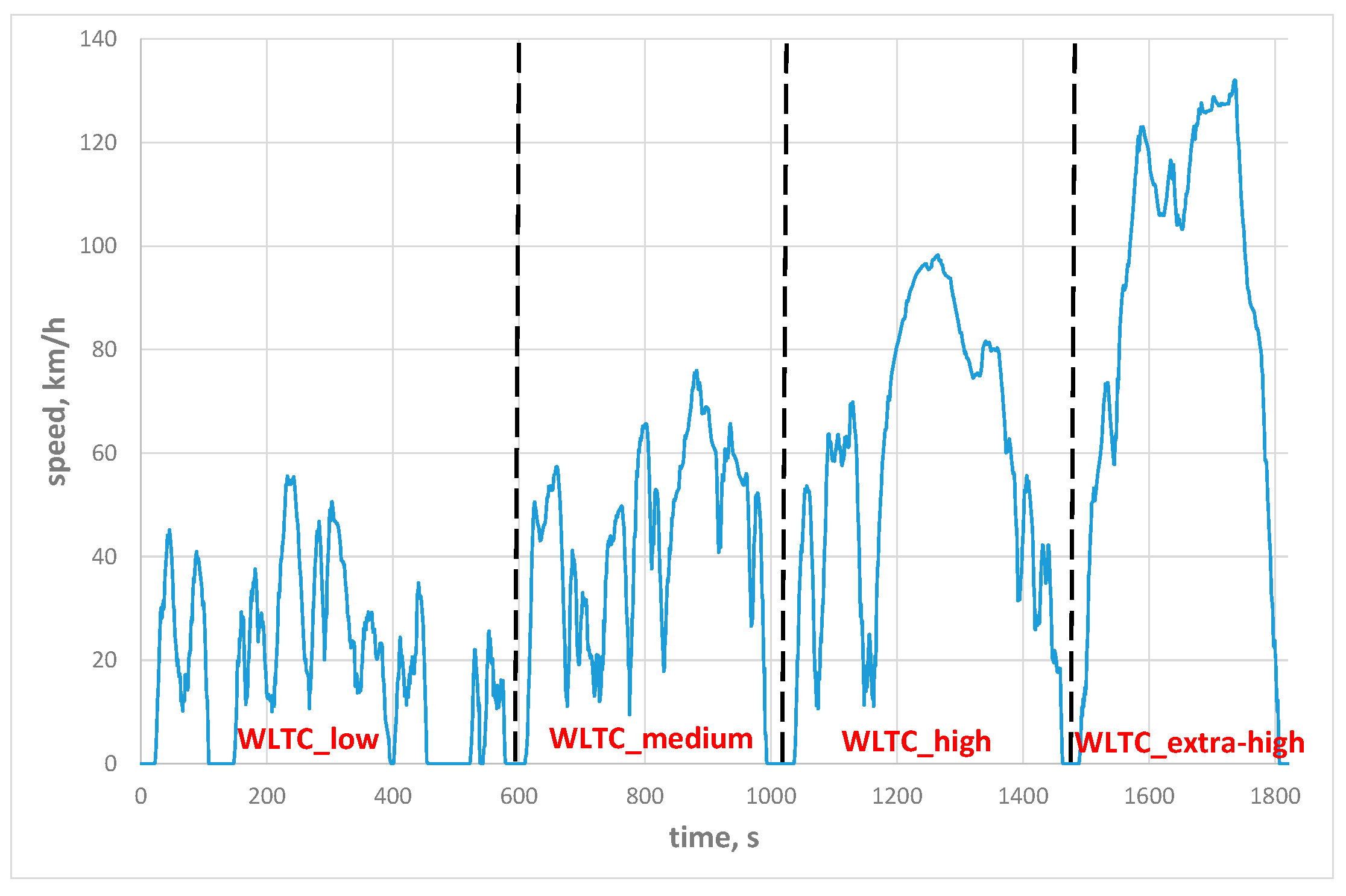
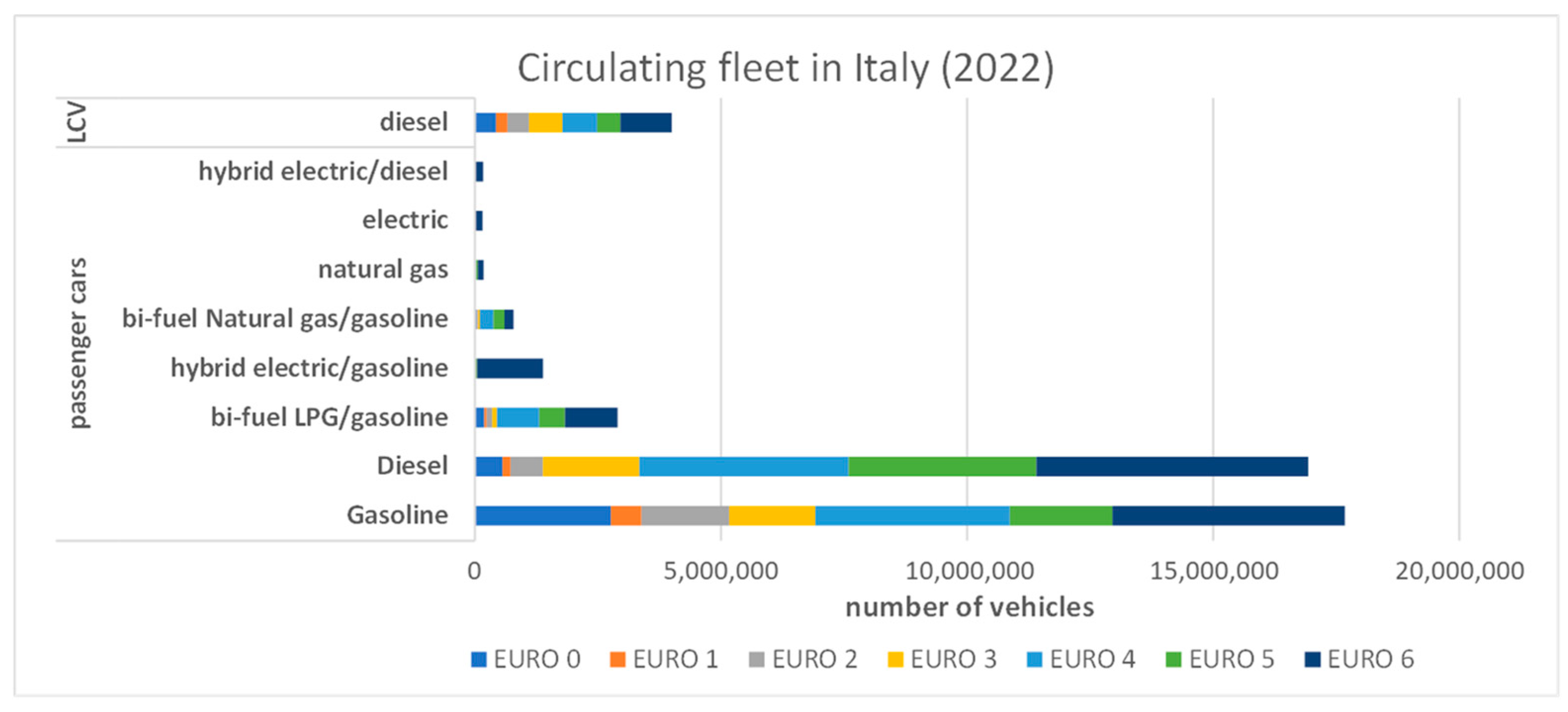
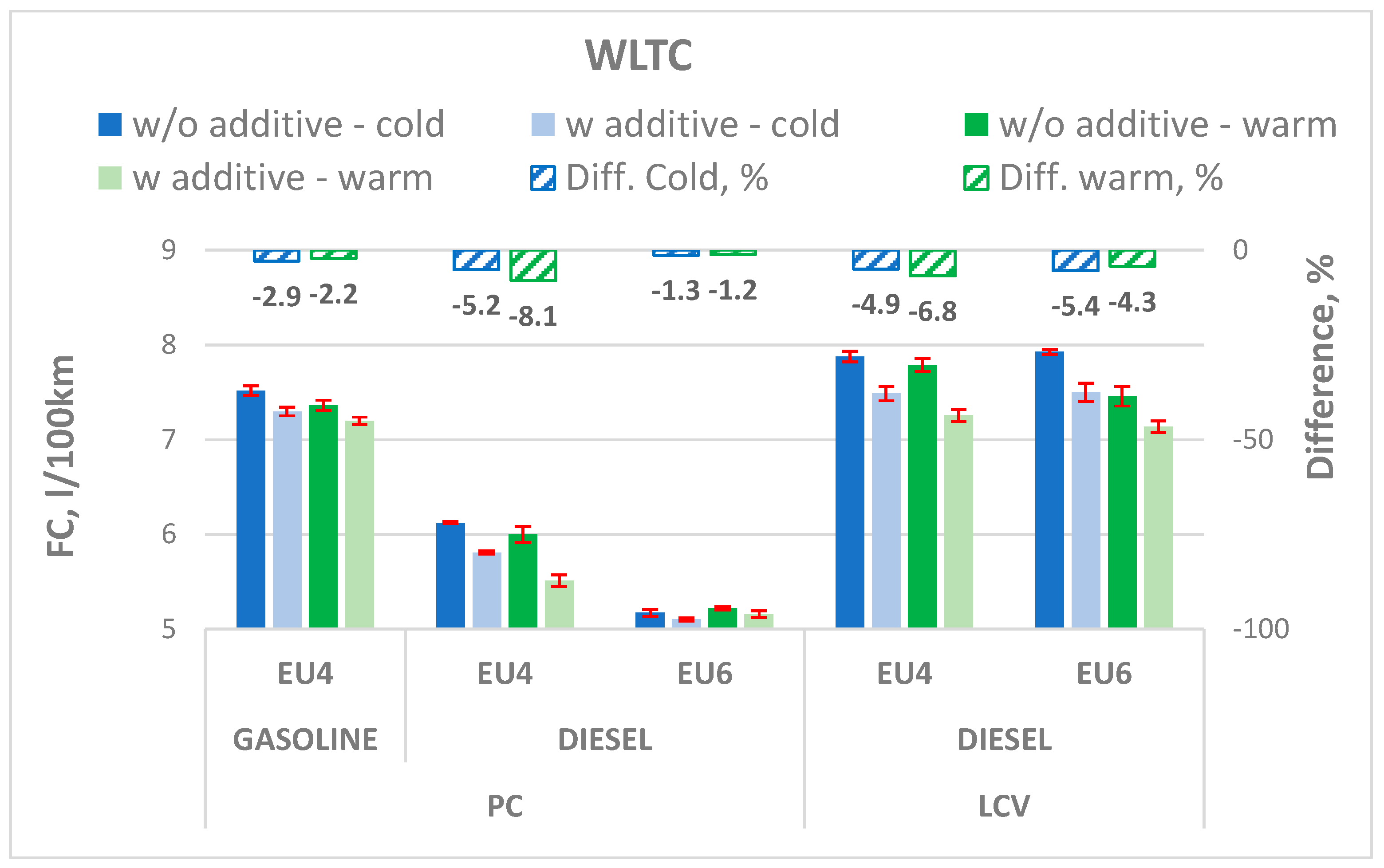
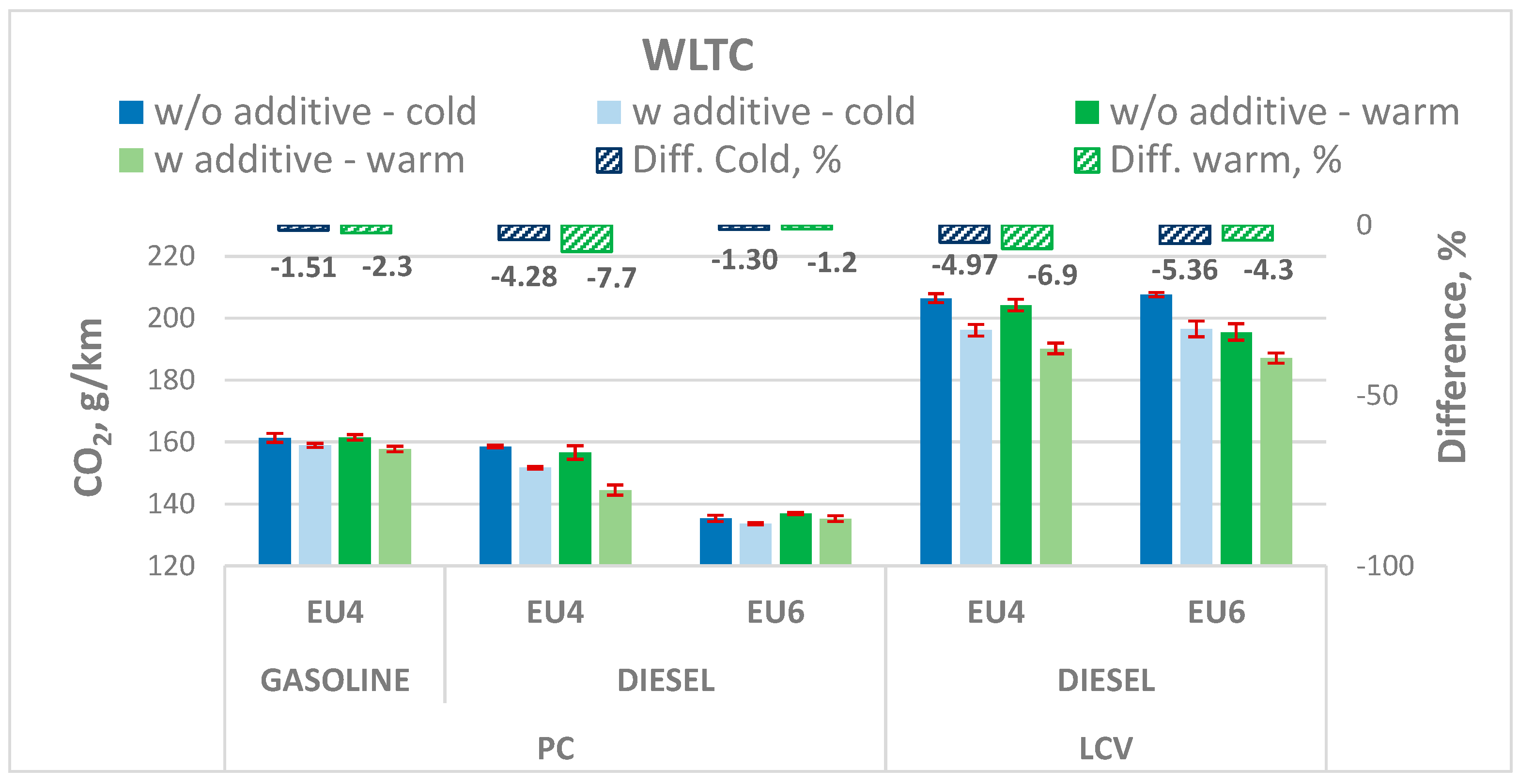


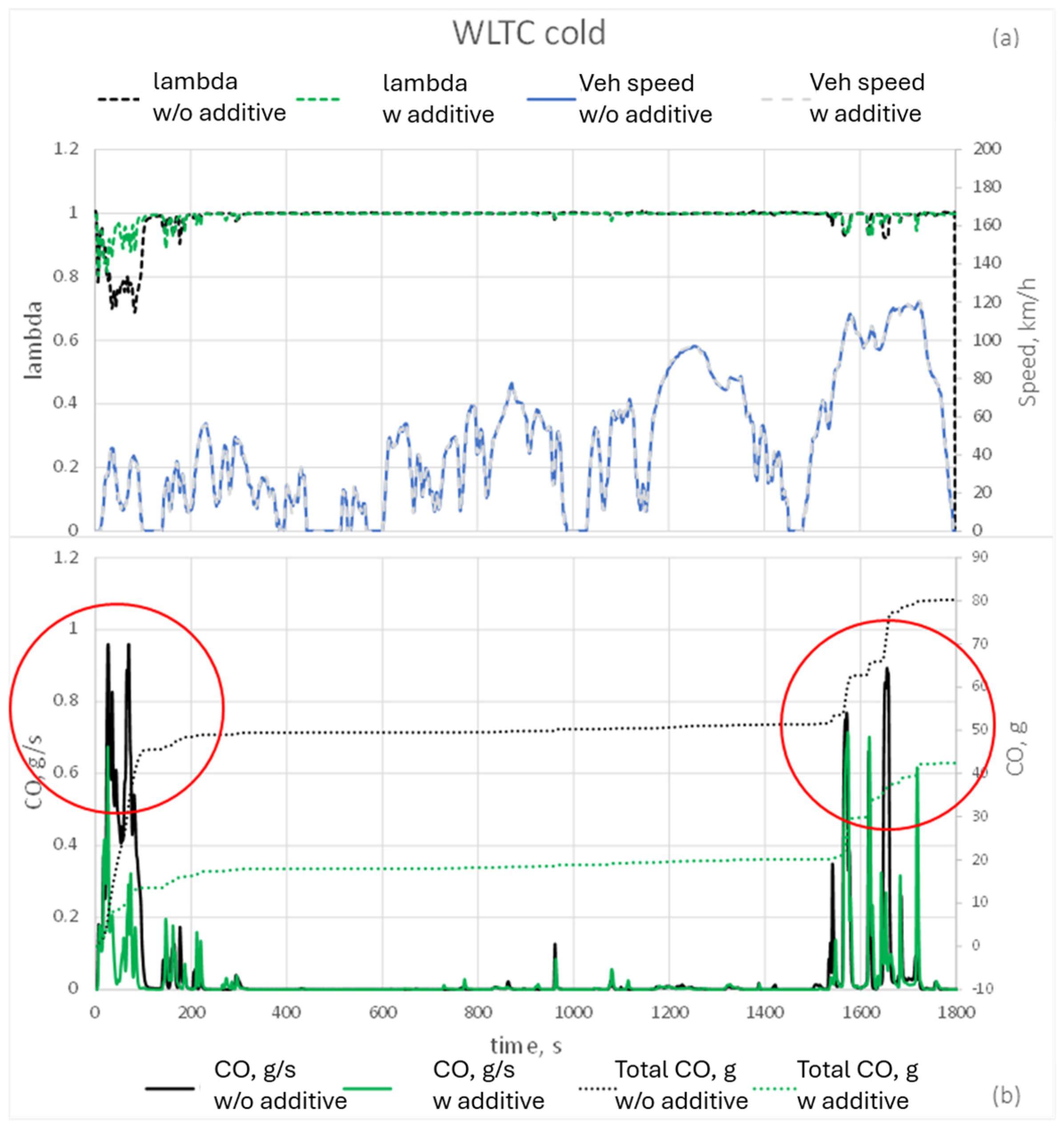
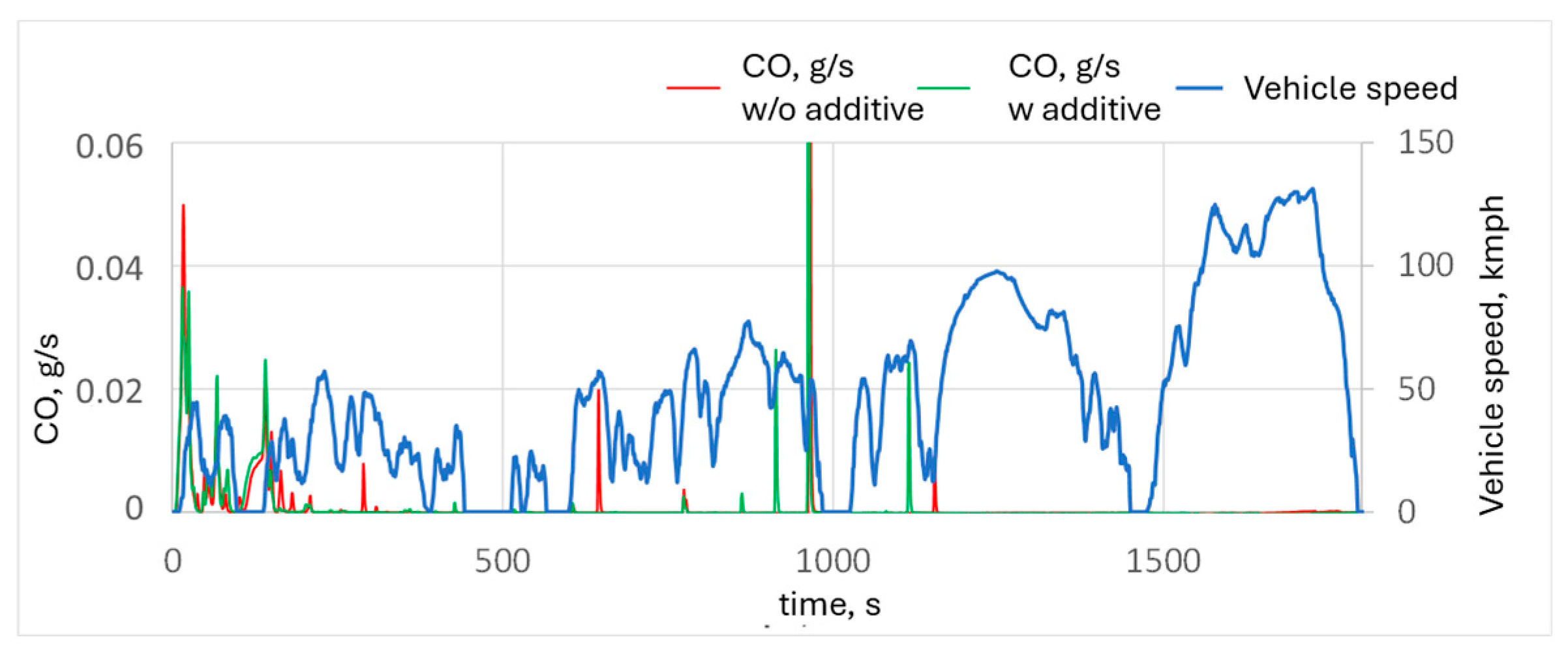
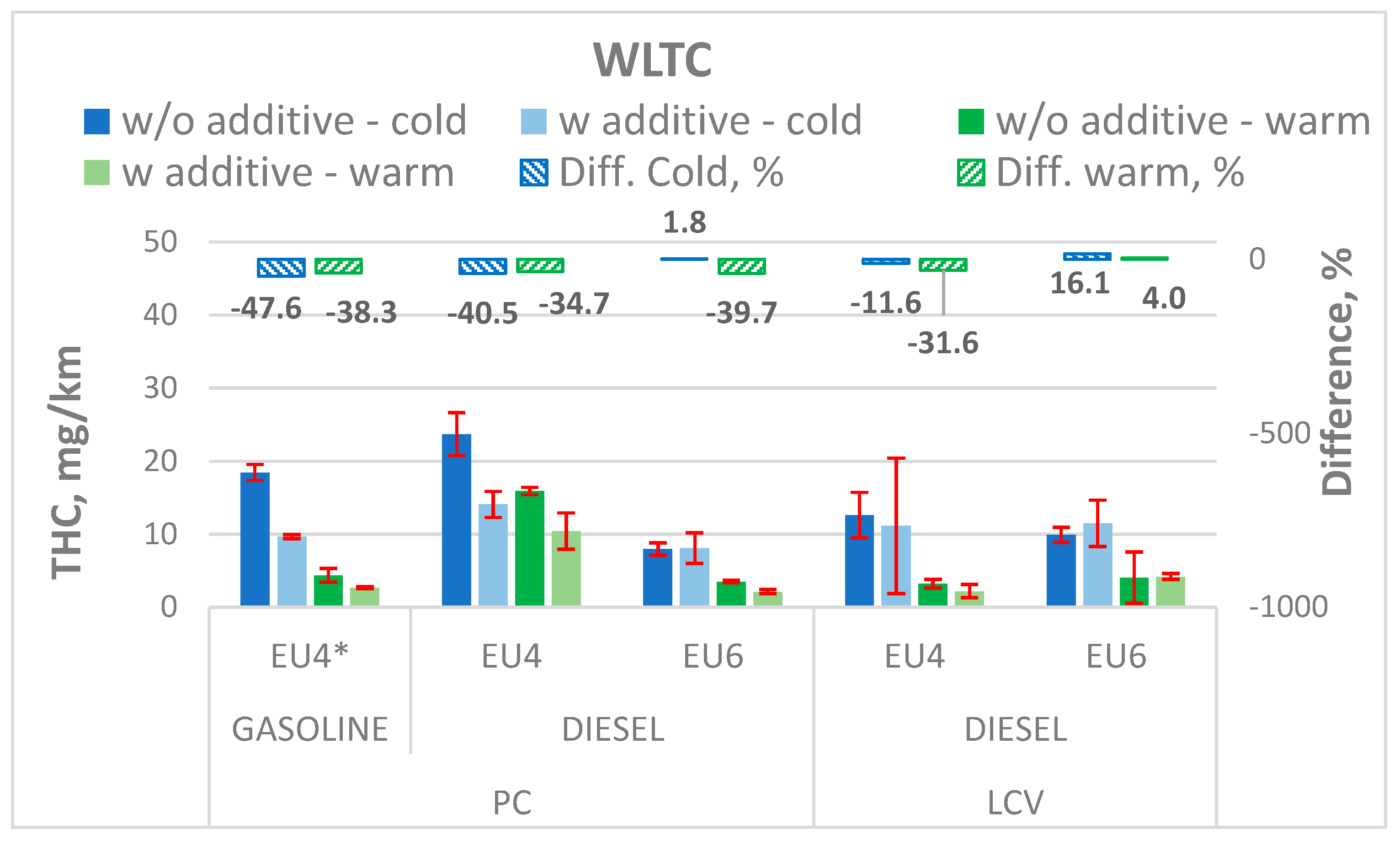
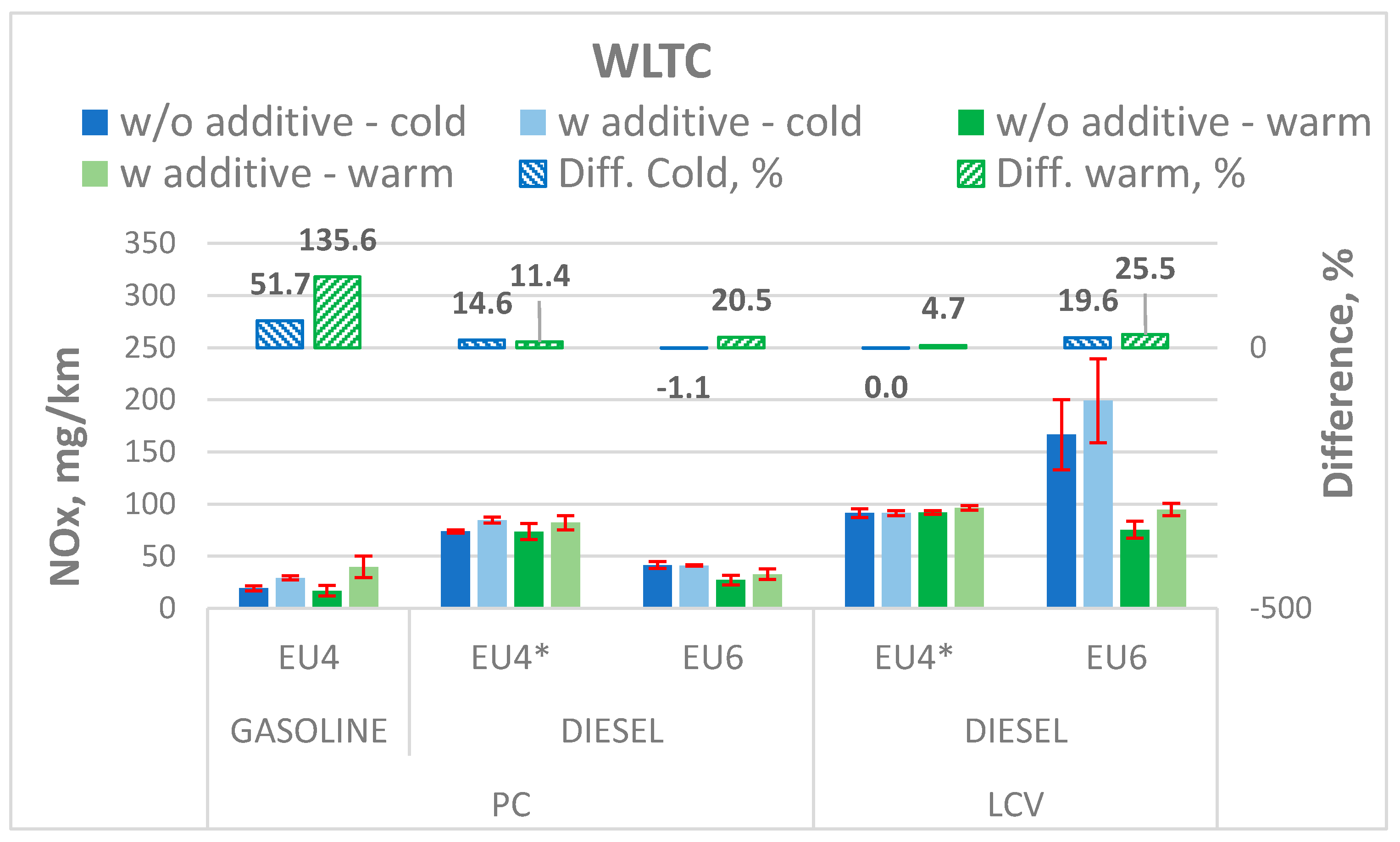

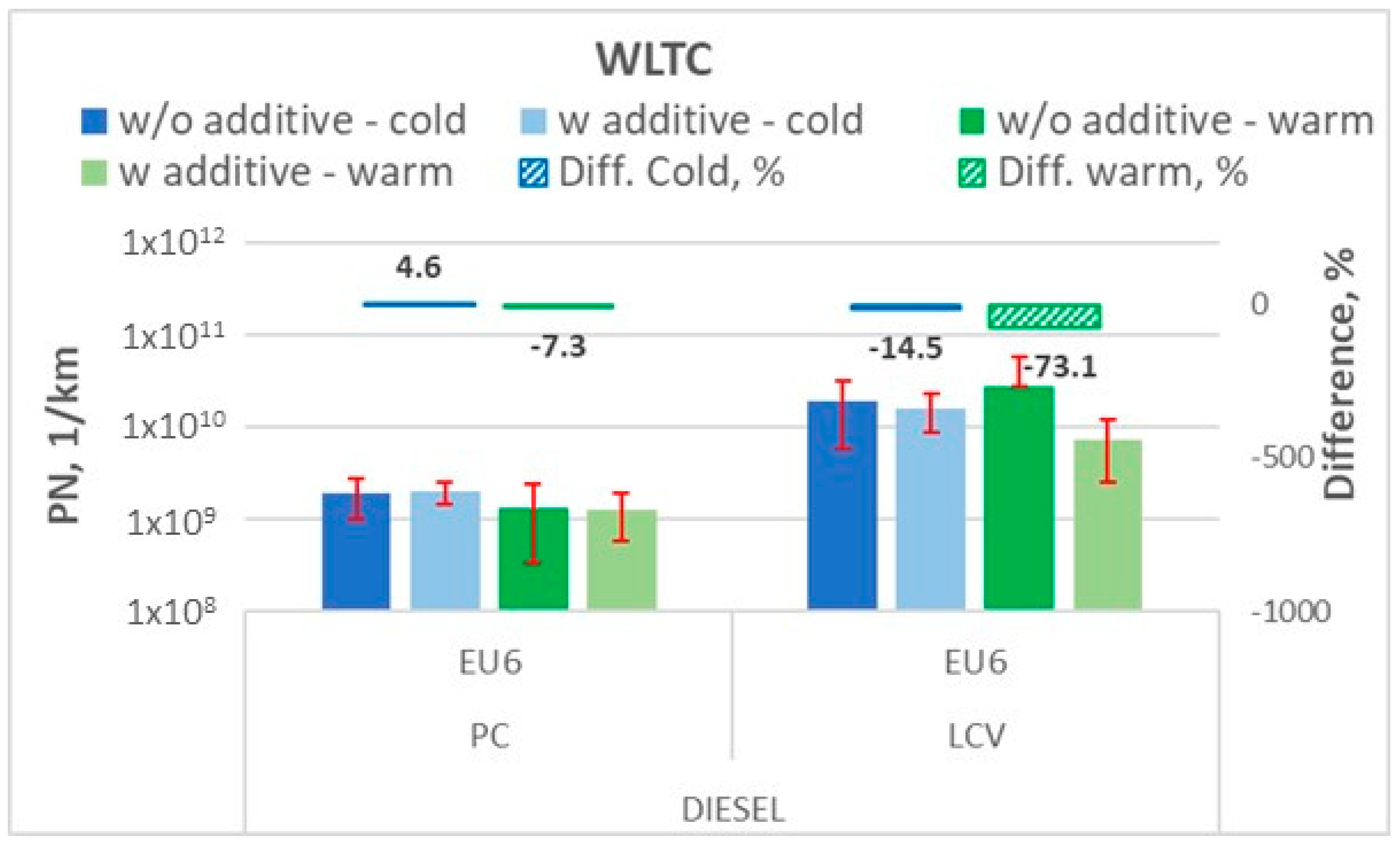
| G_PC_EU4 | D_PC_EU4 | D_PC_EU6 | D_LCV_EU4 | D_LCV_EU6 | |
|---|---|---|---|---|---|
| Vehicle category | M1 | M1 | M1 | N1 | N1 |
| Fuel | gasoline | Diesel | Diesel | Diesel | Diesel |
| Engine displacement, cm3 | 1242 | 1248 | 1598 | 2287 | 2299 |
| Maximum power, kW | 44 | 55 | 70 | 88 | 81 |
| Curb weight, kg | 1020 | 1235 | 1280 | 1935 | 2046 |
| EU directive | Euro 4 2001/100/CE-B | Euro 4 2003/76/CE-B | Euro 6 2016/646 ZD | Euro 4 2003/76/CE-B | Euro 6 2015/45/CE-B |
| Mileage, km | 175,000 | 176,300 | 220,771 | 145,000 | 258,365 |
| Vehicle | Driving Cycle | CO | HC | NOx | THCs + NOx | PM | PN |
|---|---|---|---|---|---|---|---|
| G_PC_EU4 | NEDC | 2.1 | 1.1 | 0.7 | |||
| D_PC_EU4 | NEDC | 0.8 | 2.8 | 2.5 | 1.5 | ||
| D_PC_EU6 | WLTC | 0.2 | 0.6 | 0.3 | 0.4 | 0.0 | |
| D_LCV_EU4 | NEDC | 0.2 | 2.2 | 2.0 | 0.4 | ||
| D_LCV_EU6 | WLTC | 0.1 | 1.3 | 0.8 | 0.3 | 0.0 |
| Parameter | Method | Units | Lower/Upper Limit | Gasoline | Additive + Gasoline |
|---|---|---|---|---|---|
| Hydrocarbons content | EN ISO 22854 | ||||
| Aromatics | % v/v | -/35.0 | 28.1 | 28.1 | |
| Olefins | % v/v | -/18.0 | 1.0 | 1.0 | |
| Benzene | % v/v | -/1.00 | 0.76 | 0.76 | |
| Sulphur | EN ISO 20884 | mg/kg | -/10.0 | <3.0 | <3.0 |
| Oxygen compounds | EN ISO 22854 | ||||
| Methanol | % v/v | -/3.0 | <0.1 | <0.1 | |
| Ethanol | % v/v | -/5.0 | <0.1 | <0.1 | |
| Isopropyl alcohol | % v/v | <0.1 | <0.1 | ||
| Isobutyl alcohol | % v/v | <0.1 | <0.1 | ||
| Tert-butyl alcohol | % v/v | 0.1 | 0.1 | ||
| Ethers | % v/v | 13.4 | 13.4 | ||
| others | % v/v | <0.1 | <0.1 | ||
| Oxygen content | % m/m | -/2.7 | 2.5 | 2.5 | |
| Corrosiveness to copper | EN ISO 2160 | Class 1 | Class 1 | Class 1 | |
| Distillation | EN ISO 3405 | ||||
| Final Boiling Point | °C | -/210.0 | 191.4 | 192.0 | |
| Residue | % v/v | -/2.0 | 0.9 | 0.9 | |
| Evaporated @ 70 °C | % v/v | 22.0/50.0 | 49.0 | 49.1 | |
| Evaporated @ 100 °C | % v/v | 46.0/71.0 | 67.8 | 68.0 | |
| Evaporated @ 150 °C | % v/v | 75.0/- | 89.8 | 89.9 | |
| Doctor test | ASTM D4952 | - | N | N | |
| Gum content | EN ISO 6246 | mg/100 mL | -/5.0 | 1.4 | 1.2 |
| Manganese | EN 16135 | mg/L | -/2.0 | <0.1 | <0.1 |
| Density @ 15 °C | UNI EN ISO 12185 | kg/L | 0.72/0.775 | 0.7338 | 0.7340 |
| Motor Octane Number | EN ISO 5163 | - | 85.0/- | 87.3 | 87.3 |
| Research Octane Number | EN ISO 5164 | - | 95.0/- | 95.3 | 95.3 |
| Pb | UNI EN 237 | mg/L | -/5.0 | <2.5 | <2.5 |
| Flash Point | ASTM D56 | °C | -/21 | <21 | <21 |
| Oxidation stability | EN ISO 7536 | min | 360/- | >400 | >400 |
| Vapour Pressure | EN 13016-1 | kPa | 60.0/90.0 | 63.0 | 62.8 |
| Parameter | Method | Units | Lower/Upper Limit | Diesel | Additive + Diesel | |
|---|---|---|---|---|---|---|
| Water | EN ISO 12937 | mg/kg | -/200 | 90 | 95 | |
| CFPP | EN 116 | °C | -/−10 | −15 | −15 | |
| Particulate contamination | EN 12662 | mg/kg | -/24.0 | 17.0 | 15.0 | |
| FAME | EN14078 | % v/v | -/7.0 | 6.7 | 6.7 | |
| Sulphur | EN ISO 20884 | mg/kg | -/10.0 | 7.5 | 7.5 | |
| Copper corrosion (3 h @50 °C) | EN ISO 2160 | Class 1A | Class 1A | |||
| Distillation | T95 | EN ISO 3405 | °C | -/360.0 | 354.2 | 354.5 |
| @250 °C | % v/v | -/65 | 38.4 | 38.4 | ||
| @350 °C | % v/v | 85.0/- | 93.9 | 94.0 | ||
| I.B.P. | °C | 174.4 | 180.5 | |||
| F.B.P. | °C | 367.8 | 368.5 | |||
| PAH | EN 12916 | % m/m | -/8.0 | 4.4 | 4.4 | |
| Manganese | EN 16576 | mg/L | -/2.0 | <0.02 | <0.02 | |
| Density@ 15 °C | EN ISO 12185 | kg/m3 | 820.0/845.0 | 834.5 | 834.5 | |
| Cetane number | ISO 5165 | - | 51.0/- | 52.2 | 56.4 | |
| Cetane Index | EN ISO 4264 | - | 46.0/- | 52.8 | 53.0 | |
| Lubricity (wsd @ 60 °C) | ISO 12156-1 | μm | -/460 | 336 | 335 | |
| Flash Point | EN ISO 2719 | °C | >55 | 68.0 | 67.5 | |
| Carbon Residue | ISO 10370 | % m/m | -/0.300 | <0.001 | <0.001 | |
| Ash | ISO 6245 | % m/m | -/0.001 | 0.001 | 0.002 | |
| Oxidation stability | ISO 12205 | g/m3 | -/25.0 | 2.5 | 1.4 | |
| Oxidation stability | UNI EN 15751 | h | >20 | >20 | ||
| Viscosity @ 40 °C | EN ISO 3104 | mm2/s | 2.000/4.500 | 2.680 | 2.691 | |
| Cloud Point | ASTM D7689 | °C | −5.0 | −5.0 | ||
Disclaimer/Publisher’s Note: The statements, opinions and data contained in all publications are solely those of the individual author(s) and contributor(s) and not of MDPI and/or the editor(s). MDPI and/or the editor(s) disclaim responsibility for any injury to people or property resulting from any ideas, methods, instructions or products referred to in the content. |
© 2024 by the authors. Licensee MDPI, Basel, Switzerland. This article is an open access article distributed under the terms and conditions of the Creative Commons Attribution (CC BY) license (https://creativecommons.org/licenses/by/4.0/).
Share and Cite
Marchitto, L.; Costagliola, M.A.; Berra, A. Influence of Performance Packages on Fuel Consumption and Exhaust Emissions of Passenger Cars and Commercial Vehicles under WLTP. Energies 2024, 17, 3356. https://doi.org/10.3390/en17143356
Marchitto L, Costagliola MA, Berra A. Influence of Performance Packages on Fuel Consumption and Exhaust Emissions of Passenger Cars and Commercial Vehicles under WLTP. Energies. 2024; 17(14):3356. https://doi.org/10.3390/en17143356
Chicago/Turabian StyleMarchitto, Luca, Maria Antonietta Costagliola, and Alessandra Berra. 2024. "Influence of Performance Packages on Fuel Consumption and Exhaust Emissions of Passenger Cars and Commercial Vehicles under WLTP" Energies 17, no. 14: 3356. https://doi.org/10.3390/en17143356






